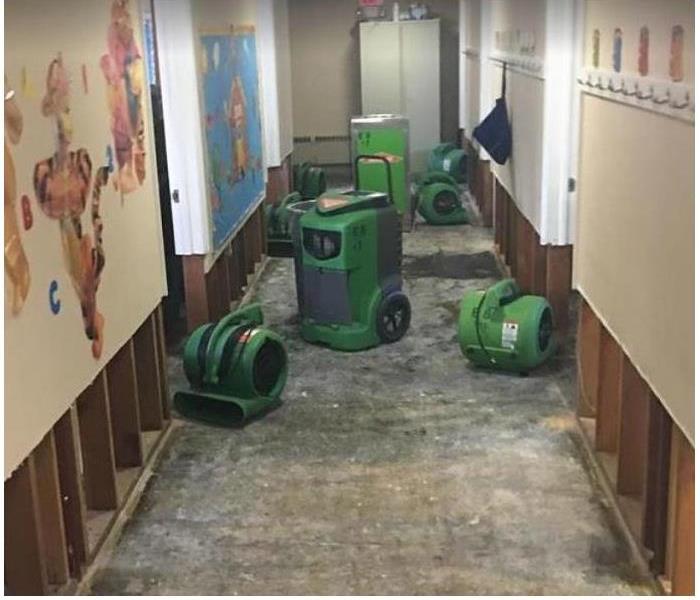Why Do Restorers Cut Holes and Remove Drywall During East Brunswick Water Extraction?
5/19/2020 (Permalink)
Trust Our Skilled Team to Explain Why SERVPRO Choses Certain Water Removal Strategies in East Brunswick Residences
When significant water damage strikes your home, the last thing you might expect from a company promising to help is what seems like even more damage. During our years in the water loss response business, we have learned to commit to regular and open communication with our customers. This clarity is especially important when we see the need for controlled demolition to facilitate water extraction and structural drying while avoiding long-term secondary damage in East Brunswick.
Is It Unusual for Residential Water Losses to Involve Vast Quantities of Damaging Fluids?
Active water removal in East Brunswick is critical to minimizing permanent harm to your home’s structure and contents. After a pipe breaks or the washing machine pump malfunctions, it takes just a brief time for vast amounts of water to spill into your home. A supply line can unleash a hundred gallons in an hour. Add the pumping action of an appliance, and the water can increase exponentially. Engaging professionals to address the crisis is essential because consumer-grade equipment does not have the power of capacity to manage the volumes involved.
What Is Involved in Effective Water Removal?
Our research-based approach to water removal is why SERVPRO can deliver consistent and successful results. Our employees, managers, and technicians alike complete a rigorous course of training from the Institute of Inspection, Cleaning and Restoration Certification (IICRC). The IICRC is an international restoration standards development organization, disseminating the industry’s best practices through the Water Damage Restoration Technicians (WRT) it trains and certifies. Expect the following from our team during your water removal project:
- A thorough safety assessment before commencement of water removal activities
- An emergency services phase once safety concerns are controlled
- Pumping of water deeper than two inches
- Truck-mounted extraction to remove the remaining standing water
- Use of portable extractors and wand extensions to reach water in confined areas
- A testing phase to set up for structural drying
- Infrared imaging to locate pooled and trapped water using temperature fluctuations
- Moisture detection to define the perimeter of the water spread
- Moisture level measurement to serve as a baseline for drying goals
- Controlled demolition if evidence indicates trapped liquid and absorbed water is otherwise inaccessible
Is Controlled Demolition Really Necessary?
When our crew chief approaches you, you might ask why we suggest one or more methods of planned demolition as part of our water removal and drying strategy. As we scope your East Brunswick home for hidden water damage, we are always aware that water cannot remain for long in building cavities. Progressive deterioration of building materials and mold damage are nearly guaranteed if we do not take the steps necessary to gain access to and rid your dwelling of the water.
What Is a Flood Cut?
Drywall construction is a common risk factor leading to trapped water. As the water spreads toward the juncture between the floor and wall, the fluid absorbs into the highly porous drywall. The drywall wicks the water up and permits some of it to collect behind it as well. In cases where the water loss is on an upper level, the water can flow down between walls, also pooling and needing release. When our moisture detection tools signal water is trapped, we might determine a flood cut is indicated.
- Several inches above the waterline, we use saws to cut between studs, removing and disposing of the wet material.
- Exposed water is extracted.
Are Less Intrusive Methods Available?
We can pry off baseboards and drill or cut holes near the bottom of a wall to release water. When water intrudes into cinder block or brick surfaces, we use a drill through mortar joints to allow for water to flow out for capture by a wanded extractor. Sometimes when holes are drilled, we attach hoses and use negative air pressure to suction the fluids.
How Do Flood Cuts and Drilled Holes Help with Structural Drying?
When controlled demolition releases the water, it also opens access into the confined wet spaces. This access is another reason why we choose partial tear outs. The free airflow and application of heat encourage evaporation, the most effective way to move water out of structural components and into the air where we capture it with our dehumidifiers.
What Is the Answer for My Purposely Damaged Walls?
Replacing drywall and filling in cut and drilled holes are tasks we can arrange to have completed. The construction experts on our team make sure the demolition completes appropriately, and then can help rebuild once the water and lingering moisture evacuate.
Our IICRC certification and construction division are two of many reasons why SERVPRO of East Brunswick / Princeton Meadows gives our customers peace of mind at a difficult time. Call (732) 432-9800 to learn how our approach to restoration can make it “Like it never even happened.”






 24/7 Emergency Service
24/7 Emergency Service
